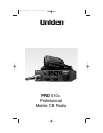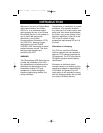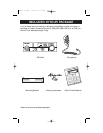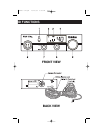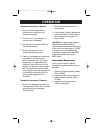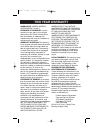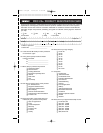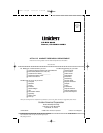
Connecting the Power Cord
With regard to the connection of the power cords,
it may be possible or desirable to connect the red
lead (for negative ground systems) or the black
lead (for positive ground systems) to the ignition
switch accessory terminal so that the radio is
automatically turned off when the ignition switch
(key) is turned off.
Alternately, the power lead may be connected to
an available terminal on the fuse block or even to
a point in the wiring harness. Care must be
taken, however, to guard against a short circuit
condition.When in doubt, please contact your
vehicle dealer fro specific information about your
vehicle.
Ground Information
Most newer U.S. and foreign made cars and
small trucks use a negative ground system, while
some older cars and some newer larger trucks
may use a positive ground system. A negative
ground system is generally identified by the “-”
battery terminal being connected to the vehicle
motor block, but if you cannot determine the
polarity of your vehicle, consult your vehicle
dealer for information.
NOTE: This radio may be installed and used in
any 12-volt DC negative or positive ground
system.
Negative Ground System
If you are operating on a negative ground
system, connect the red DC power cord from the
radio to the positive “+” battery terminal or other
convenient point and connect the black power
lead to the chassis or vehicle frame, or the “ -”
terminal of the battery.
Positive Ground System
If you are operating on a positive ground system,
connect the black DC power cord from the radio
to the “-” battery terminal or other convenient
point and connect the red power lead to the
chassis or vehicle frame, or the positive “+”
terminal of the battery.
Plan the location of the radio and microphone
bracket before starting installation. Select a
location that is convenient for operation and does
not interfere with the driver or passenger in the
vehicle. The radio should be securely fastened to
a solid surface using the mounting bracket and
self-tapping screws which are provided.
Mobile Antenna
Since the maximum allowable power output of
the transceiver is limited by the FCC, the antenna
is a very important factor affecting the
transmission distance. It is for this reason that we
strongly recommend that you install only a quality
antenna in your new CB radio system.You have
purchased a superior quality transceiver. Don’t
diminish its performance by installing an inferior
antenna.
Only a properly matched antenna system will
allow maximum power transfer from the 50-ohm
transmission line to the radiating element.We
recommend that you use an SWR meter when
installing your antenna. Set your PRO 510
XL to
channel 20 and make your adjustments to the
antenna until the meter reads as close to 1 as
possible.Your Uniden dealer is qualified to assist
you in the selection of the proper antenna to
meet your application requirements.
For automobile installation, the whip antenna
may be used with good effect.The most efficient
and practical installation is a full quarter wave
whip antenna mounted on the rear deck or fender
top, midway between the rear window and
bumper.
A short “loaded” whip antenna maybe more
convenient to install on your automobile, although
the efficiency is less than a full quarter wave
whip antenna.
For marine installation, consult your dealer for
information regarding an adequate grounding
system and prevention of electrolysis between
fittings on the hull and water.
INSTALLATION
PRO510 om.qxd 11/19/99 3:58 PM Page 6



